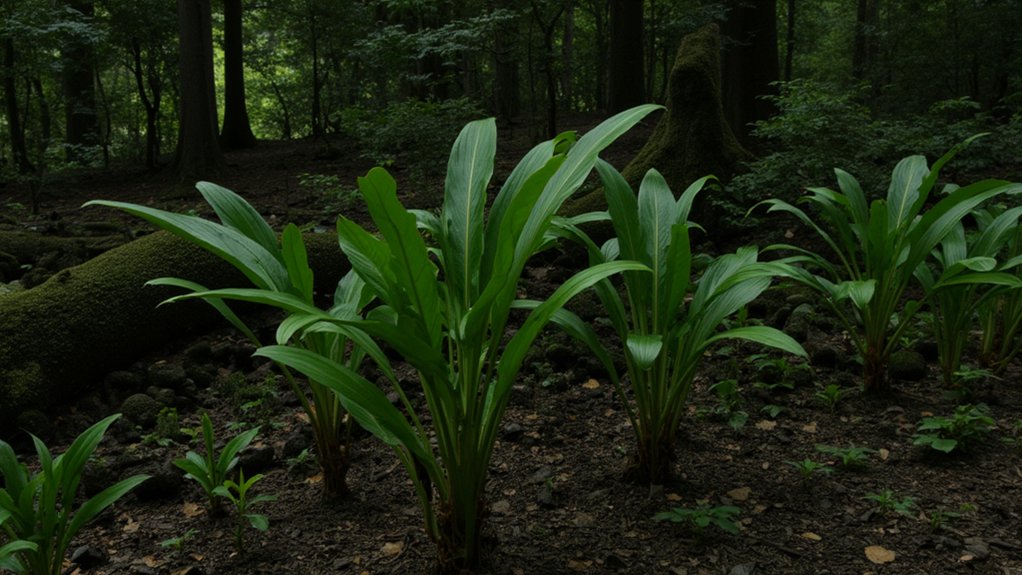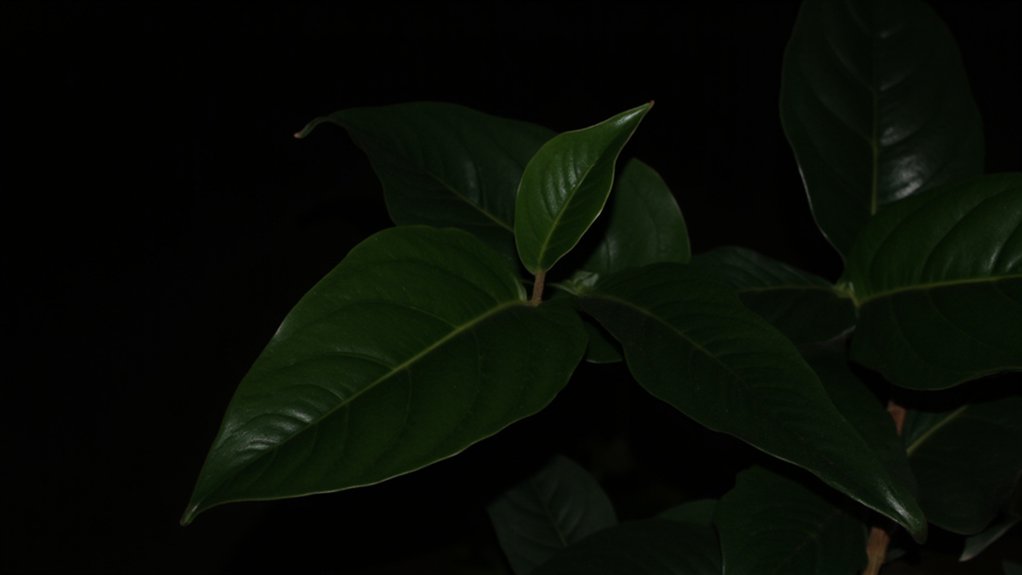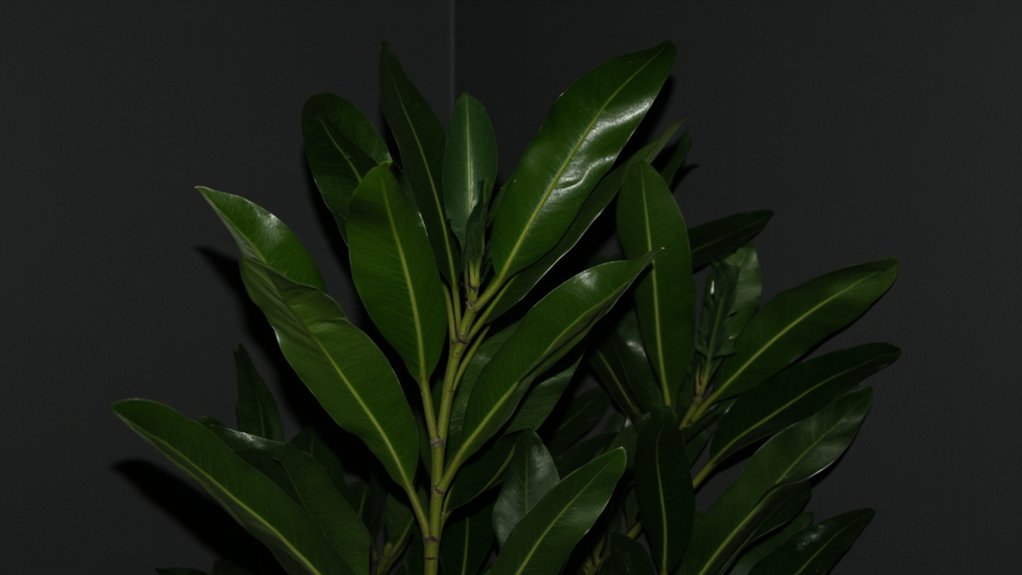While ZZ plants are celebrated for their near-indestructible nature, their ability to survive in complete darkness isn’t quite the superpower many believe it to be. You’ll find these resilient houseplants can endure extremely low light conditions for up to four months, thanks to their specialized rhizomes and adaptive leaf structures. Before you tuck your ZZ plant into a lightless corner, though, there’s essential science behind their survival that might surprise you.
Contents
- 1 Understanding ZZ Plant’s Natural Habitat
- 2 The Evolution of Light Adaptation Mechanisms
- 3 Breaking Down ZZ Plant’s Survival Strategy
- 4 Debunking Common Light Deprivation Myths
- 5 Minimum Light Requirements for Growth
- 6 Signs of Insufficient Light Exposure
- 7 Optimal Light Conditions for Healthy Growth
- 8 Long-term Effects of Low Light on ZZ Plants
Understanding ZZ Plant’s Natural Habitat

The ZZ plant’s native habitat stretches across the dry, tropical regions of Eastern Africa, from Kenya to Zanzibar. You’ll find these hardy plants thriving in shaded areas beneath dense forest canopies, where light levels can drop as low as 2-5% of full sunlight.
In their natural environment, ZZ plants have adapted to survive long periods of drought by developing thick, potato-like rhizomes that store water and nutrients. They’ve also evolved large, dark green leaves that efficiently capture what little light filters through the forest canopy, allowing them to photosynthesize even in dim conditions.
The Evolution of Light Adaptation Mechanisms

Over millions of years, ZZ plants developed remarkable adaptations that let them thrive in low-light environments. Their specialized leaves contain high concentrations of chlorophyll, allowing them to photosynthesize efficiently even in dim conditions.
You’ll find that ZZ plants evolved thick, waxy cuticles that reduce water loss and protect their leaves from environmental stress. Their unique cellular structure includes specialized organelles that store energy from even brief exposure to light.
The plant’s underground rhizomes, which evolved around 15 million years ago, act as natural batteries, storing water and nutrients that sustain growth during extended periods of darkness.
Breaking Down ZZ Plant’s Survival Strategy

While most plants struggle in darkness, ZZ plants implement a sophisticated three-part survival strategy. First, they’ll draw upon stored water and nutrients in their potato-like rhizomes, which can sustain them for up to four months without light. Next, they’ll slow their metabolism by up to 70%, conserving energy and reducing their need for photosynthesis.
Finally, you’ll notice them maximizing what little light they receive through specialized leaf adaptations. Their waxy, dark green leaves can absorb and process even minimal light from distant windows or artificial sources, helping them photosynthesize in conditions that would kill other houseplants.
Debunking Common Light Deprivation Myths
Despite widespread claims about ZZ plants thriving in complete darkness, you’ll need to separate fact from fiction to keep your plant healthy. While ZZ plants can tolerate low light, they can’t photosynthesize without any light at all.
You’ve probably heard that ZZ plants can survive in windowless bathrooms or basement corners, but that’s not entirely accurate. They need at least some indirect light to maintain growth, even if it’s minimal. Your plant might survive for several months in very dim conditions, but it won’t thrive or produce new growth without access to some natural or artificial light.
Minimum Light Requirements for Growth
To maintain healthy growth, your ZZ plant needs at least 60-75 foot-candles of indirect light daily, which you can measure using a light meter or smartphone app. While ZZ plants can survive in lower light conditions, they won’t thrive below this threshold.
Place your plant within 3-6 feet of a north-facing window, or behind a sheer curtain near east or west-facing windows. You’ll notice slower growth and potential leaf yellowing if light levels drop below 50 foot-candles for extended periods.
During winter months, you might need to relocate your ZZ plant closer to light sources, as natural daylight decreases considerably.
Signs of Insufficient Light Exposure
Your ZZ plant will send clear visual signals when it’s not getting enough light. The most noticeable signs include elongated, spindly stems that stretch toward light sources, with increased spacing between leaves. These etiolated stems appear pale and weak compared to healthy growth.
You’ll notice new growth becomes smaller than existing leaves, while the plant’s overall growth rate slows considerably. The distinctive dark green color may fade to a lighter shade, and leaves might start drooping or yellowing, particularly on the lower portions. In severe cases, you’ll see stems becoming leggy and toppling over, unable to support themselves properly.
Optimal Light Conditions for Healthy Growth
Although ZZ plants can tolerate low light conditions, they’ll truly thrive in bright, indirect sunlight for 6-8 hours daily. You’ll want to position your plant 3-6 feet away from east or north-facing windows, where it can receive filtered morning light without harsh afternoon rays.
For ideal growth, you can rotate your ZZ plant 45 degrees every two weeks to guarantee even light distribution. If you’re using artificial lighting, position LED grow lights 12-24 inches above the plant’s canopy, running them for 12-14 hours per day. In offices, place your ZZ plant within 6 feet of fluorescent lighting for consistent growth.
Long-term Effects of Low Light on ZZ Plants
While ZZ plants can persist in darker conditions, extended periods of insufficient light will gradually take their toll. You’ll first notice slower growth, with new stems emerging less frequently and reaching only half their typical size. After 3-4 months, the plant’s dark green leaves may begin yellowing, especially on lower stems.
If you keep your ZZ plant in low light for 6+ months, it’ll develop leggy growth as it searches for light sources. The spaces between leaves will stretch to 2-3 inches, compared to the usual 1-inch gaps. Without intervention, you’ll see stem elongation, leaf drop, and eventually, reduced rhizome development.
